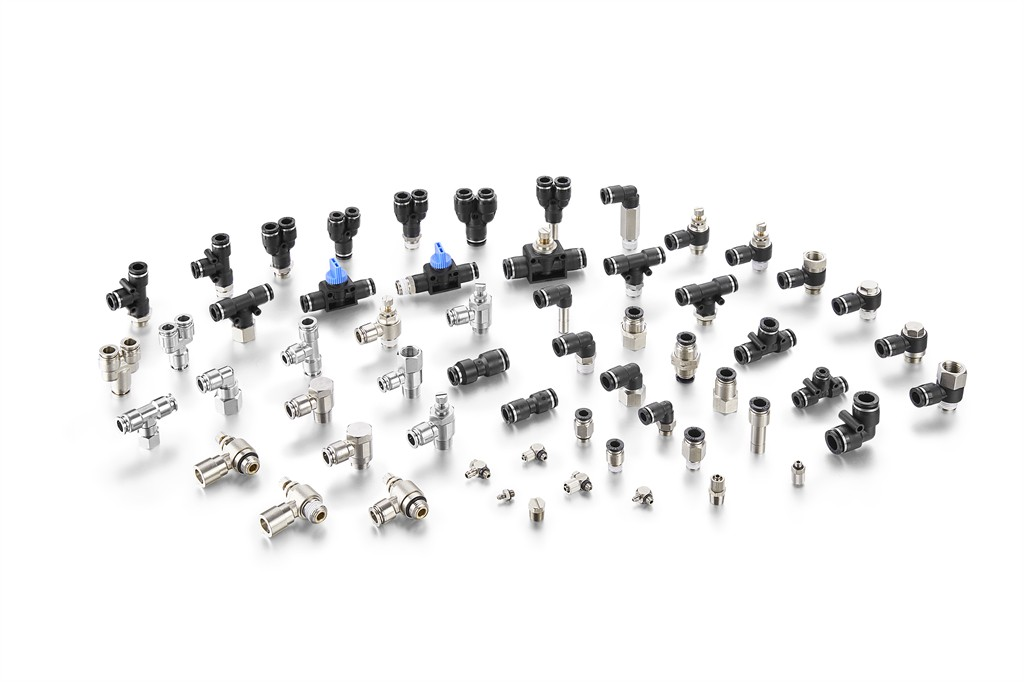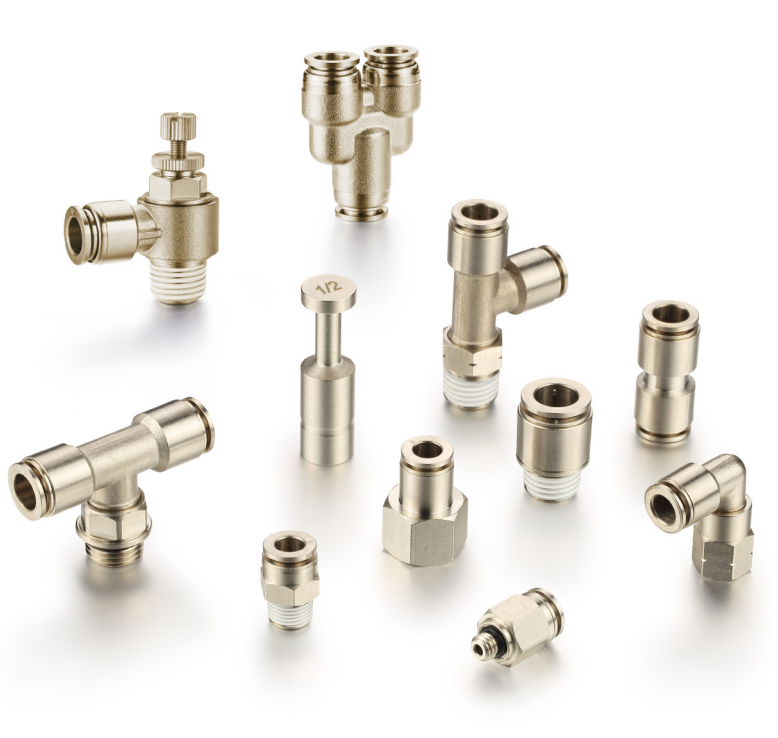Introduction
When it comes to designing and optimizing pneumatic systems, the choice of fittings can significantly impact both performance and efficiency. Push-to-connect fittings and threaded fittings are among the most common options available to engineers and technicians. While both have their place in pneumatic systems, push-to-connect fittings have gained popularity for a variety of compelling reasons—particularly in modern industrial applications.
Push-to-connect fittings, also known as push-in or instant fittings, are designed for quick and easy installation. They eliminate the need for wrenches or other tools, reducing potential installation errors and saving valuable time. This simplicity is one of their most pronounced advantages over traditional threaded fittings, which require precise sealing processes and tools. For many professionals in the field, the convenience and reliability of push-to-connect fittings make them a preferred choice.
Furthermore, the operational efficiencies gained through the use of push-to-connect fittings cannot be overstated. By reducing labor costs, minimizing the potential for system leaks, and allowing for rapid maintenance and reconfiguration, these fittings contribute directly to improved system uptime and reduced total cost of ownership. In today’s fast-paced industrial landscape, these savings are crucial.
In this article, we delve deeply into the reasons why push-to-connect fittings are often favored over their threaded counterparts. By exploring their design, benefits, real-world applications, and potential drawbacks, you’ll gain comprehensive insight into why this seemingly small component can have a major impact on your pneumatic system’s performance.
What Are Push-to-Connect Fittings and How Do They Work?
Design and Functionality
Push-to-connect fittings are engineered to provide a swift, secure connection between tubing and system components. Their design typically comprises a body, collet, and O-ring. The body holds the collet securely, while the O-ring ensures a tight seal around the tube when inserted. This intuitive design allows for easy insertion and removal—simply pushing the tube into the fitting creates a secure connection.
The collet plays a crucial role. It features teeth or gripping parts that hold the tube in place, ensuring stability even in high-pressure applications. The O-ring, often made from elastomers like nitrile or Viton, provides a leak-proof seal that withstands various operating conditions.
Installation Process
Installing a push-to-connect fitting is straightforward and intuitive:
- Cut the Tube: The tube end should be square and free from burrs for optimal performance.
- Insert the Tube: Push the tube into the fitting until it bottoms out.
- Check the Connection: Tug lightly to ensure the tube is securely fastened.
Removal is equally simple; pressing the collet and pulling the tube releases it without damage.
Material Composition
Push-to-connect fittings are manufactured in a variety of materials, including plastic, brass, and stainless steel. Each material offers distinct advantages:
- Plastic: Lightweight and corrosion-resistant, ideal for low-pressure, non-abrasive environments.
- Brass: Durable and resistant to many chemicals, suitable for medium to high-pressure applications.
- Stainless Steel: Extremely robust and corrosion-resistant, excellent for high-pressure and harsh environments.

What Are the Advantages of Push-to-Connect Fittings Over Threaded Fittings?
Ease of Installation and Removal
Push-to-connect fittings are renowned for their time-saving installation. Unlike threaded fittings, which require wrenches and careful alignment to avoid leaks, push-to-connect fittings can be installed without tools. This ease of installation not only saves time but also reduces the potential for operator error.
Flexibility and Versatility
These fittings are incredibly versatile, accommodating a wide range of tube materials and diameters. This adaptability makes them suitable for diverse applications, from compressed air systems to fluid handling.
Reduced Risk of Leaks
Threaded fittings rely on thread sealing materials like PTFE tape to prevent leaks, which can sometimes fail if improperly applied. In contrast, push-to-connect fittings achieve a secure seal directly with an integrated O-ring. This design minimizes leakage risks and simplifies maintenance.
Lower Labor and Maintenance Costs
By reducing installation time and complexity, push-to-connect fittings can lower labor costs significantly. Their ease of use also means less downtime during maintenance, enhancing overall operational efficiency.
What Are the Key Applications for Push-to-Connect Fittings?
Industrial Automation
In industrial automation, quick adaptability is a necessity. Push-to-connect fittings allow for rapid configuration changes and maintenance, essential in dynamic environments like assembly lines.
Automotive Applications
These fittings are widely used in the automotive industry for air brake systems and fuel lines. Their reliability and ease of use make them ideal for applications where safety is paramount.
HVAC Systems
For heating, ventilation, and air conditioning systems, push-to-connect fittings provide leak-free connections in refrigeration lines, facilitating swift and efficient installations.
Food and Beverage Industry
Given their ability to provide hygienic and secure connections, push-to-connect fittings are preferred in food and beverage processing where cleanliness is key.

Are There Drawbacks to Using Push-to-Connect Fittings?
Pressure Limitations
While push-to-connect fittings are suitable for many applications, they might not be ideal for extremely high-pressure environments. Threaded fittings can sometimes offer greater pressure resistance depending on the design.
Material Compatibility
Not all push-to-connect fittings are compatible with every type of fluid or gas. For aggressive chemicals, careful material selection is necessary to prevent breakdown or failure.
Initial Cost Considerations
On the surface, push-to-connect fittings can be more expensive per unit than some threaded options. However, consideration of total lifetime costs often justifies the initial expense.
How to Choose the Right Push-to-Connect Fitting for Your Application?
Assessing Material Needs
Selecting the right material based on environmental conditions and fluid compatibility is critical. Factors like temperature, pressure, and chemical exposure play a significant role in determining the suitable material.
Understanding Load and Pressure Requirements
Ensure the chosen fitting can withstand the operational pressure and load without risk of failure. This involves consulting technical specifications and possibly conducting pressure tests.
Evaluating System Requirements
Consider the entire system’s configuration and demands. Does the application require frequent disassembly? Are there space constraints? Tailoring the fitting choice to these considerations ensures optimal performance.
Considering Compliance and Standards
Ensure that fittings meet industry standards and certifications relevant to your application, such as ISO or FDA standards, to maintain regulatory compliance.
Conclusion
Push-to-connect fittings offer remarkable benefits that often make them a preferred choice over threaded fittings in many applications. Their ease of installation, reduced risk of leaks, and flexibility make them indispensable in modern pneumatic systems. By selecting the right materials and ensuring compatibility with system requirements, these fittings can significantly enhance performance and reduce operational costs.
Incorporating push-to-connect fittings into your pneumatic systems can lead to substantial efficiencies and reliability gains, providing a competitive edge in today’s demanding industrial environments. As technology continues to evolve, staying informed about the latest advancements in fittings technology will ensure your systems remain at the forefront of efficiency and performance.

